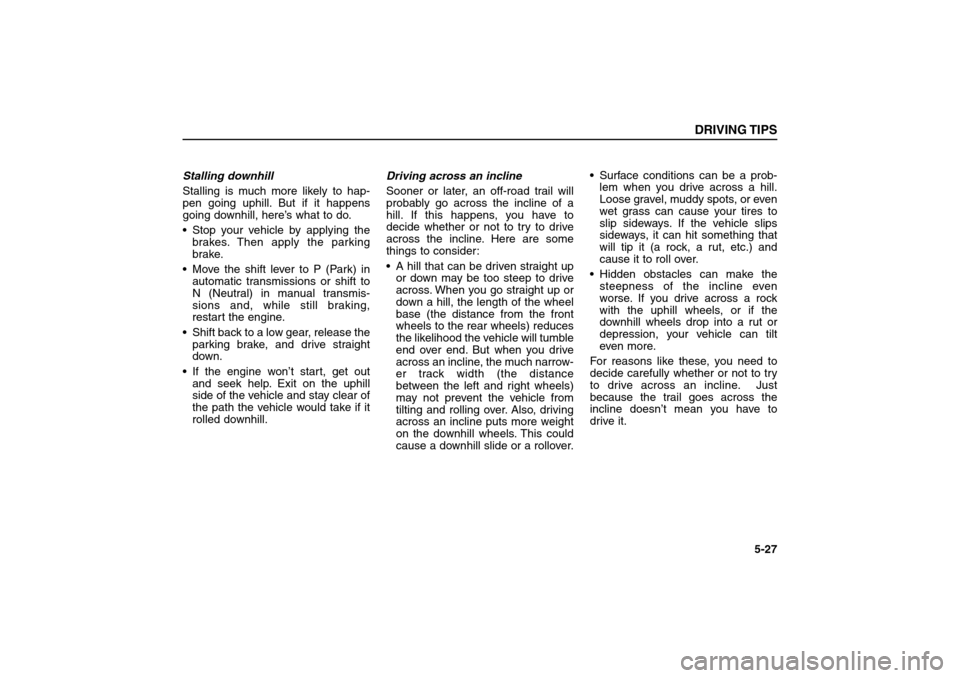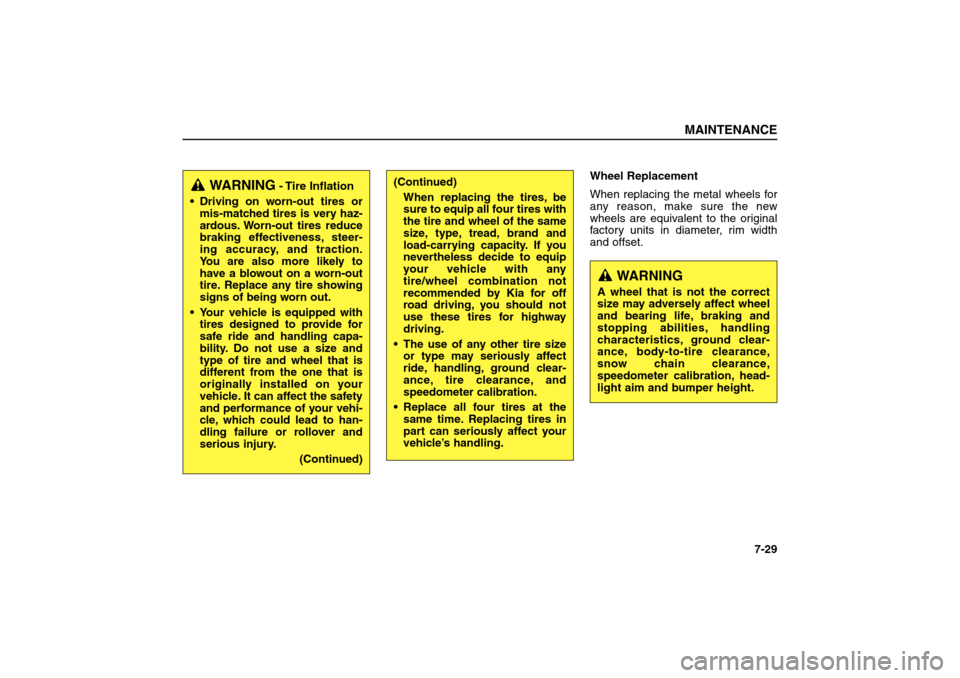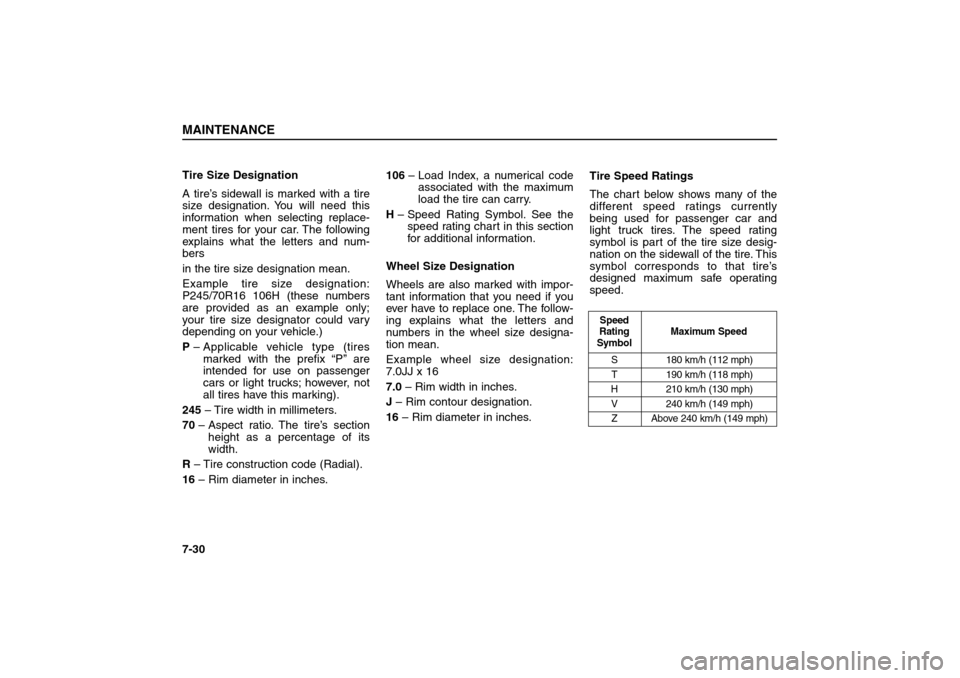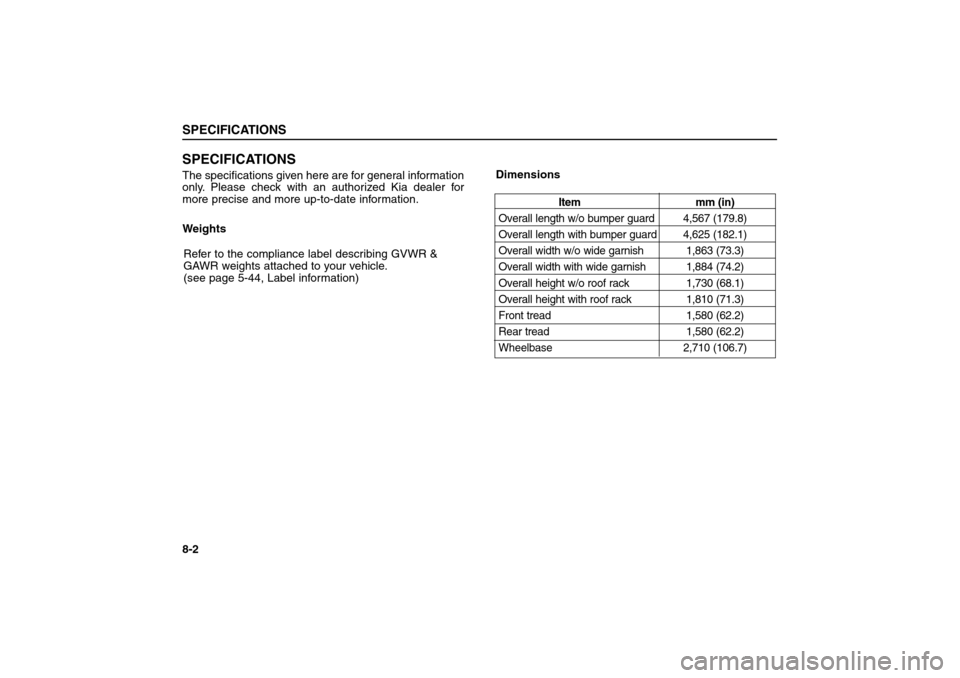width KIA Sorento 2006 1.G Owner's Manual
[x] Cancel search | Manufacturer: KIA, Model Year: 2006, Model line: Sorento, Model: KIA Sorento 2006 1.GPages: 312, PDF Size: 5.21 MB
Page 214 of 312

Stalling downhill
Stalling is much more likely to hap-
pen going uphill. But if it happens
going downhill, here’s what to do.
Stop your vehicle by applying the
brakes. Then apply the parking
brake.
Move the shift lever to P (Park) in
automatic transmissions or shift to
N (Neutral) in manual transmis-
sions and, while still braking,
restart the engine.
Shift back to a low gear, release the
parking brake, and drive straight
down.
If the engine won’t start, get out
and seek help. Exit on the uphill
side of the vehicle and stay clear of
the path the vehicle would take if it
rolled downhill.Driving across an incline
Sooner or later, an off-road trail will
probably go across the incline of a
hill. If this happens, you have to
decide whether or not to try to drive
across the incline. Here are some
things to consider:
A hill that can be driven straight up
or down may be too steep to drive
across. When you go straight up or
down a hill, the length of the wheel
base (the distance from the front
wheels to the rear wheels) reduces
the likelihood the vehicle will tumble
end over end. But when you drive
across an incline, the much narrow-
er track width (the distance
between the left and right wheels)
may not prevent the vehicle from
tilting and rolling over. Also, driving
across an incline puts more weight
on the downhill wheels. This could
cause a downhill slide or a rollover. Surface conditions can be a prob-
lem when you drive across a hill.
Loose gravel, muddy spots, or even
wet grass can cause your tires to
slip sideways. If the vehicle slips
sideways, it can hit something that
will tip it (a rock, a rut, etc.) and
cause it to roll over.
Hidden obstacles can make the
steepness of the incline even
worse. If you drive across a rock
with the uphill wheels, or if the
downhill wheels drop into a rut or
depression, your vehicle can tilt
even more.
For reasons like these, you need to
decide carefully whether or not to try
to drive across an incline. Just
because the trail goes across the
incline doesn’t mean you have to
drive it.
DRIVING TIPS
5-27
BL-ENG (CAN)-5.qxd 7/28/05 5:56 PM Page 27
Page 286 of 312

Wheel Replacement
When replacing the metal wheels for
any reason, make sure the new
wheels are equivalent to the original
factory units in diameter, rim width
and offset.
MAINTENANCE
7-29
WARNING
- Tire Inflation
Driving on worn-out tires or
mis-matched tires is very haz-
ardous. Worn-out tires reduce
braking effectiveness, steer-
ing accuracy, and traction.
You are also more likely to
have a blowout on a worn-out
tire. Replace any tire showing
signs of being worn out.
Your vehicle is equipped with
tires designed to provide for
safe ride and handling capa-
bility. Do not use a size and
type of tire and wheel that is
different from the one that is
originally installed on your
vehicle. It can affect the safety
and performance of your vehi-
cle, which could lead to han-
dling failure or rollover and
serious injury.
(Continued)
(Continued)
When replacing the tires, be
sure to equip all four tires with
the tire and wheel of the same
size, type, tread, brand and
load-carrying capacity. If you
nevertheless decide to equip
your vehicle with any
tire/wheel combination not
recommended by Kia for off
road driving, you should not
use these tires for highway
driving.
The use of any other tire size
or type may seriously affect
ride, handling, ground clear-
ance, tire clearance, and
speedometer calibration.
Replace all four tires at the
same time. Replacing tires in
part can seriously affect your
vehicle’s handling.
WARNING
A wheel that is not the correct
size may adversely affect wheel
and bearing life, braking and
stopping abilities, handling
characteristics, ground clear-
ance, body-to-tire clearance,
snow chain clearance,
speedometer calibration, head-
light aim and bumper height.
BL-ENG (CAN)-7.qxd 7/28/05 5:58 PM Page 29
Page 287 of 312

Tire Size Designation
A tire’s sidewall is marked with a tire
size designation. You will need this
information when selecting replace-
ment tires for your car. The following
explains what the letters and num-
bers
in the tire size designation mean.
Example tire size designation:
P245/70R16 106H (these numbers
are provided as an example only;
your tire size designator could vary
depending on your vehicle.)
P– Applicable vehicle type (tires
marked with the prefix “P’’are
intended for use on passenger
cars or light trucks; however, not
all tires have this marking).
245– Tire width in millimeters.
70 – Aspect ratio. The tire’s section
height as a percentage of its
width.
R – Tire construction code (Radial).
16– Rim diameter in inches.106– Load Index, a numerical code
associated with the maximum
load the tire can carry.
H– Speed Rating Symbol. See the
speed rating chart in this section
for additional information.
Wheel Size Designation
Wheels are also marked with impor-
tant information that you need if you
ever have to replace one. The follow-
ing explains what the letters and
numbers in the wheel size designa-
tion mean.
Example wheel size designation:
7.0JJ x 16
7.0– Rim width in inches.
J– Rim contour designation.
16– Rim diameter in inches.Tire Speed Ratings
The chart below shows many of the
different speed ratings currently
being used for passenger car and
light truck tires. The speed rating
symbol is part of the tire size desig-
nation on the sidewall of the tire. This
symbol corresponds to that tire’s
designed maximum safe operating
speed.MAINTENANCE7-30
S 180 km/h (112 mph)
T 190 km/h (118 mph)
H 210 km/h (130 mph)
V 240 km/h (149 mph)
Z Above 240 km/h (149 mph)
Maximum Speed Speed
Rating
Symbol
BL-ENG (CAN)-7.qxd 7/28/05 5:58 PM Page 30
Page 306 of 312

SPECIFICATIONSThe specifications given here are for general information
only. Please check with an authorized Kia dealer for
more precise and more up-to-date information.SPECIFICATIONS8-2
Item mm (in)
Overall length w/o bumper guard 4,567 (179.8)
Overall length with bumper guard 4,625 (182.1)
Overall width w/o wide garnish 1,863 (73.3)
Overall width with wide garnish 1,884 (74.2)
Overall height w/o roof rack 1,730 (68.1)
Overall height with roof rack 1,810 (71.3)
Front tread 1,580 (62.2)
Rear tread 1,580 (62.2)
Wheelbase 2,710 (106.7)
Dimensions
Weights
Refer to the compliance label describing GVWR &
GAWR weights attached to your vehicle.
(see page 5-44, Label information)
BL-ENG (CAN)-8.qxd 7/28/05 5:59 PM Page 2